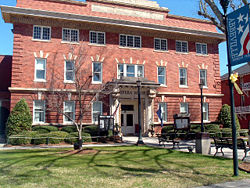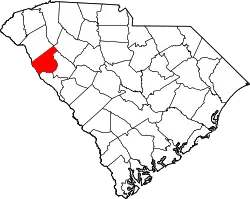Abbeville, South Carolina
| Abbeville, South Carolina | |
| Abbeville Opera House | |
| Coordinates: {{#invoke:Coordinates|coord}}{{#coordinates:34|10|43|N|82|22|45|W|type:city | |
|---|---|
| name= }} | |
| Country | United States |
| State | South Carolina |
| County | Abbeville |
| Area | |
| - Total | 5.9 sq mi (15.2 km²) |
| - Land | 5.9 sq mi (15.2 km²) |
| - Water | 0.0 sq mi (0.0 km²) |
| Elevation | 591 ft (180 m) |
| Population (2000) | |
| - Total | 5,840 |
| - Density | 995.2/sq mi (384.3/km²) |
| Time zone | Eastern (EST) (UTC-5) |
| - Summer (DST) | EDT (UTC-4) |
| ZIP code | 29620 |
| Area code(s) | 864 |
| FIPS code | 45-00100GR2 |
| GNIS feature ID | 1244839GR3 |
For other communities of the same name, see Abbeville (disambiguation).
Abbeville is a city in Abbeville County, South Carolina, United States, 86 miles (138 km) west of Columbia. Its population was 5,840 at the 2000 census. It is the county seat of Abbeville CountyGR6. Settled by French immigrants, it was named along with the county for the French town of the same name.[1]
Geography
Abbeville is located at {{#invoke:Coordinates|coord}}{{#coordinates:34|10|43|N|82|22|45|W|city | |name= }} (34.178572, -82.379200).GR1
According to the United States Census Bureau, the city has a total area of 15.2 km² (5.9 mi²), all land.
Demographics
As of the censusGR2 of 2000, there were 5,840 people, 2,396 households, and 1,574 families residing in the city. The population density was 995.2 people per square mile (384.1/km²). There were 2,654 housing units at an average density of 452.3/sq mi (174.6/km²). The racial makeup of the city was 50.46% White, 48.48% African American, 0.12% Native American, 0.26% Asian, 0.02% Pacific Islander, 0.19% from other races, and 0.48% from two or more races. Hispanic or Latino of any race were 0.75% of the population.
There were 2,396 households out of which 30.7% had children under the age of 18 living with them, 37.1% were married couples living together, 23.9% had a female householder with no husband present, and 34.3% were non-families. 30.6% of all households were made up of individuals and 13.9% had someone living alone who was 65 years of age or older. The average household size was 2.39 and the average family size was 2.97.
In the city the population was spread out with 27.2% under the age of 18, 8.8% from 18 to 24, 25.9% from 25 to 44, 21.2% from 45 to 64, and 16.8% who were 65 years of age or older. The median age was 36 years. For every 100 females there were 80.4 males. For every 100 females age 18 and over, there were 73.9 males.
The median income for a household in the city was $25,756, and the median income for a family was $30,040. Males had a median income of $28,339 versus $21,824 for females. The per capita income for the city was $13,274. About 16.3% of families and 19.8% of the population were below the poverty line, including 29.2% of those under age 18 and 20.9% of those age 65 or over.
Abbeville is the center of a small urban cluster with a total population of 6,038 (2000 census).
Abbeville and the American Civil War
Abbeville has the unique distinction of being both the birthplace and the deathbed of the Confederacy. On November 22, 1860, a meeting was held at Abbeville, at a site since dubbed "Secession Hill", to launch South Carolina's secession from the Union; one month later, the state of South Carolina became the first state to secede.
It was also the birthplace of noted states rights advocate John C. Calhoun. On March 18, 1782, John C. Calhoun was born near Abbeville, South Carolina. Calhoun became a congressman, senator, secretary of war, secretary of state, and vice president of the United States. He was the first vice-president born as a United States citizen. Calhoun served as the seventh Vice President of the United States, first under John Quincy Adams (1825-1829) and then under Andrew Jackson (1829-1832), but resigned the Vice Presidency to enter the United States Senate, where he had more power. He also served in the United States House of Representatives (1810-1817) and was both Secretary of War (1817-1824) and Secretary of State (1844-1845). He is buried in the graveyard of St. Phillip’s Episcopal Church in Charleston, South Carolina.
At the end of the Civil War, with the Confederacy in shambles, Confederate President Jefferson Davis fled Richmond, Virginia and headed south, stopping for a night in Abbeville at the home of his friend Armistead Burt. It was on May 2, 1865, in the front parlor of what is now known as the Burt-Stark Mansion that Jefferson Davis officially acknowledged the dissolution of the Confederate government.
Trinity Episcopal Church was founded in 1842. The cornerstone was laid in 1859 at the current address of 200 Church Street at a cost of $15,665.00 dollars that included the organ. The church steeple sits 120 feet high and is easily seen within downtown Abbeville. The church grounds also include a cemetery which holds both Confederate and Union soldiers.[2]
Lynching
Lynching in 1916 in Abbeville, SC by a crowd estimated to be between 200 and 400 blood-thirsty white people. His ordeal lasted all day. His body was beaten and dragged through town to show other Negroes what would happen to them if they got "insolent." Finally, he was taken to the county fair grounds and strung up to a tree and riddled with bullets. Although we have heard his body was thrown on someone’s lawn , we have yet to locate his grave. The family was ordered to vacate their land, wind up business and get out of town. They did just that. His crime you might ask: cursing a white man for offering him a low price for the cotton seed he was trying to sell and being too rich for a Negro.
Anthony P. Crawford was born in January, 1865 and owned by Ben and Rebecca Crawford in Abbeville, South Carolina. He walked 14 miles roundtrip to and from school each day and proved to be quite a scholar. When Anthony finished school he was a laborer for Ben Crawford until Thomas Crawford, Anthony's father, died in 1893 and deeded some land to Anthony, who was the only one of nine siblings able to sign his own name.
Andy, as he was known, had 13 children, all of whom lived on his land with their spouses and children. He built a school on his land for the children of blacks in Abbeville and also held an office with the Masons of South Carolina.[3]
2003 Right-of-Way Standoff
On December 8, 2003, in a 14-hour standoff that stemmed from a land-survey dispute, two Abbeville lawmen were gunned down by West Abbeville resident Steven Bixby. This siege has been compared by both sympathizers of the Bixbys and law enforcement agents to the events of Waco and Ruby Ridge. In February 2007, Steven Bixby was convicted on 17 counts including the two murders, as well as lesser charges of kidnapping and conspiracy. He was given two death sentences for the murders plus 125 years in prison on the other charges.
Notable residents
- James S. Cothan, (1830-1897), born near Abbeville, United States Congressman from South Carolina [4]
- John Henry Logan, (1822-1885), born in Abbeville, physician, served as a surgeon in the Confederate Army during the American Civil War, professor at Atlanta Medical College, and editor of the Atlanta Medical Journal.[4]
- Benjamin Glover Shields, (1808-1850), born in Abbeville, was a United States Congressman from Alabama. [4]
- John C. Calhoun, 7th American Vice President under Andrew Jackson, notable States Rights Activist, and later the 16th Secretary of State of the United States
Historic Sites
Opera House
Burt-Stark Mansion
Erskine College
Notes
- ↑ Gannett, Henry (1905). The Origin of Certain Place Names in the United States, 22.
- ↑ Historic Abbeville County Abbevillecountysc.com. Retrieved May 27, 2008.
- ↑ Doria Johnson, 1998,The Lynching of Anthony Crawford Ccharity.com. Retrieved May 27, 2008.
- ↑ 4.0 4.1 4.2 (1963) Who Was Who in America, Historical Volume, 1607-1896. Chicago: Marquis Who's Who.
ReferencesISBN links support NWE through referral fees
- Ware, Lowry. 1992. Old Abbeville: scenes of the past of a town where old time things are not forgotten. Columbia, S.C.: SCMAR. ISBN 0913363111
External links
- [1] GABBIN About Abbeville: The Greater ABBeville Information Network, Abbeville's home page
- [2] Abbeville Opera House home page
- Maps and aerial photos
- Street map from Google Maps, or Windows Live Local
- Satellite image from Google Maps, Windows Live Local, WikiMapia
- Topographic map from TopoZone
Template:Abbeville County, South Carolina
| State of South Carolina Columbia (capital) | |
| Regions | Atlantic Coastal Plain |
Blue Ridge Mountains | Grand Strand | Lake Murray Country | The Lowcountry | Metrolina | The Midlands | Olde English District | Old 96 District | Pee Dee | Piedmont | Sandhills | Sea Islands | The Upstate |
| Larger Cities | Charleston |
Columbia | Florence | Greenville | Myrtle Beach | Mount Pleasant | North Charleston | Rock Hill | Spartanburg | Sumter | |
|
Smaller Cities |
Camden |
Cayce | Easley | Hilton Head Island | Isle of Palms | Forest Acres | Gaffney | Lexington | Mauldin | North Augusta | North Myrtle Beach | Orangeburg | Simpsonville | Summerville | West Columbia | York |
| Towns | Batesburg-Leesville |
Fort Mill | Fountain Inn | Greer | Irmo | Moncks Corner | Mount Pleasant | Newberry | |
| CDPs | Berea |
Carolina Forest | Dentsville | Gantt | Ladson | Parker | Red Hill | Saint Andrews | Seven Oaks | Socastee | Taylors | Wade Hampton |
| Counties | Abbeville |
Aiken | Allendale | Anderson | Bamberg | Barnwell | Beaufort | Berkeley | Calhoun | Charleston | Cherokee | Chester | Chesterfield | Clarendon | Colleton | Darlington | Dillon | Dorchester | Edgefield | Fairfield | Florence | Georgetown | Greenville | Greenwood | Hampton | Horry | Jasper | Kershaw | Lancaster | Laurens | Lee | Lexington | Marion | Marlboro | McCormick | Newberry | Oconee | Orangeburg | Pickens | Richland | Saluda | Spartanburg | Sumter | Union | Williamsburg | York |
| Topics | History |
Famous People | Governors | Legislature | State House | Congressional Districts | Census Areas | State Parks | Rivers | Wildlife Refuges | Historic Places | Amusement Parks | Colleges and Universities | Sports Venues | Shopping Malls | TV Stations | Radio Stations | Highways | Airports |
Credits
New World Encyclopedia writers and editors rewrote and completed the Wikipedia article in accordance with New World Encyclopedia standards. This article abides by terms of the Creative Commons CC-by-sa 3.0 License (CC-by-sa), which may be used and disseminated with proper attribution. Credit is due under the terms of this license that can reference both the New World Encyclopedia contributors and the selfless volunteer contributors of the Wikimedia Foundation. To cite this article click here for a list of acceptable citing formats.The history of earlier contributions by wikipedians is accessible to researchers here:
The history of this article since it was imported to New World Encyclopedia:
Note: Some restrictions may apply to use of individual images which are separately licensed.



